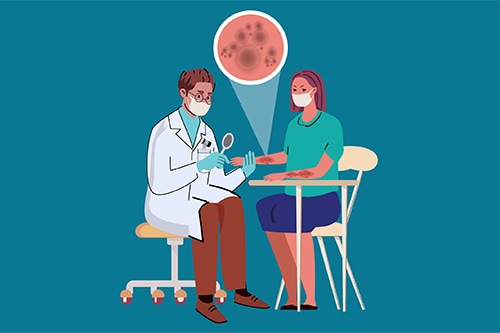Emerging severe and antimicrobial-resistant ringworm infections
Background
Public health officials concerned about potential cases of antimicrobial-resistant ringworm infections can email for recommendations and testing: FungalOutbreaks@cdc.gov.
Ringworm (also known as “tinea” and “dermatophytosis”) is a common infection of the skin, hair, or nails caused by fungi called dermatophytes. Although most cases of ringworm are not serious, people with weakened immune systems are at risk for more severe infections. Ringworm can cause stigma, intense physical discomfort, and decreased quality of life. Generally, treatment with antifungal drugs is required to cure the infection and prevent spread to others.
Over the past decade, healthcare providers have reported increasing cases of severe and antimicrobial-resistant ringworm.1 Antimicrobial resistance happens when bacteria or fungi develop the ability to defeat the drugs designed to kill them. In this case, antimicrobial-resistant ringworm infections are not killed and continue to grow when treated with antifungal drugs, making them difficult to treat.
The true number of antimicrobial-resistant ringworm cases is difficult to estimate because antifungal susceptibility testing, testing to determine if a case of ringworm can be treated by antifungal drugs, is not widely available and reporting of antimicrobial-resistant ringworm cases is not required in the United States.
Antimicrobial-resistant ringworm caused by Trichophyton indotineae (T. indotineae)

Read about how the first U.S. cases of T. indotineae were confirmed.
Trichophyton indotineae (T. indotineae), previously considered a subtype of Trichophyton mentagrophytes (T. mentagrophytes genotype VIII), is now considered its own species of dermatophyte fungus. It often has genetic mutations that make it resistant to antifungal drugs, including terbinafine, a common first-line choice. In the Indian subcontinent, cases of antimicrobial-resistant ringworm caused by T. indotineae have become widespread. Ringworm cases caused by T. indotineae are often severe (covering large regions of the body) and difficult to treat. Although cases seem to be rare outside of the Indian subcontinent, researchers have reported cases in Europe and North America.2-4, 7 Diagnosing T. indotineae infection requires advanced molecular techniques such as genomic sequencing; most clinical laboratories cannot distinguish T. indotineae from T. mentagrophytes or T. interdigitale, two other types of dermatophyte that commonly cause ringworm.
Trichophyton rubrum resistant to terbinafine
Trichophyton rubrum (T. rubrum), a dermatophyte fungus, is the most common cause of fungal nail infections (onychomycosis) and ringworm worldwide. Oral terbinafine is considered the first-line treatment for most infections caused by this fungus, but cases of terbinafine-resistant T. rubrum are increasingly being reported.5, 6 Researchers have reported cases of difficult-to-treat terbinafine-resistant T. rubrum worldwide, including in the United States.6
Severe infections caused by T. mentagrophytes, genotype VII, possibly spread during sex
T. mentagrophytes type VII can cause painful, deep inflammatory and abscessing skin infections, potentially affecting the genital region, groin, face, scalp, and other body sites. A 2023 study from France highlights 13 severe cases of ringworm caused by Trichophyton mentagrophytes, genotype VII (TMVII).8 To date, TMVII infections have not been reported in the United States. The infections described in this publication occurred primarily among men who have sex with men, were likely transmitted during sex, and could be spreading locally in Europe. The patients experienced initial misdiagnoses, treatment delays, and severe pain resulting in hospitalization.
What factors might be contributing to the emergence and spread of antimicrobial-resistant ringworm?
- Overuse of over-the-counter topical antifungal creams
- Inappropriate use of topical steroid creams
- Inappropriate prescription of antifungal drugs
- Inadequate adherence to prescribed courses of antifungal medication
- Global travel and migration from regions where antimicrobial-resistant infections are more common
What CDC is doing
CDC works closely with partners from state and local health departments, academia, international organizations, and other federal agencies to address issues surrounding antimicrobial resistance.
CDC leads and supports several projects related to ringworm through its Antimicrobial Resistance Solutions Initiative, including:
- Performing outreach to healthcare providers and professional societies to raise awareness of antimicrobial-resistant ringworm and improve adherence to guidelines for ringworm diagnosis and treatment
- Supporting studies to better understand the burden of antimicrobial-resistant ringworm in the United States, with an emphasis on preventing further spread
- Increasing laboratory capacity for antifungal susceptibility testing
- Hay RJ. The Spread of Resistant Tinea and the Ingredients of a Perfect Storm. Dermatology. 2022;238(1):80-81.
- Gupta AK, Venkataraman M, Hall DC, Cooper EA, Summerbell RC. The emergence of Trichophyton indotineae: implications for clinical practice. Int J Dermatol 2022. Epub July 22, 2022.
- Kano R, Kimura U, Kakurai M, et al. Trichophyton indotineae sp. nov.: a new highly terbinafine-resistant anthropophilic dermatophyte species. Mycopathologia 2020. Dec;185(6):947–58.
- Uhrlaß S, Verma SB, Gräser Y, et al. Trichophyton indotineae–an emerging pathogen causing recalcitrant dermatophytoses in India and worldwide–a multidimensional perspective. J Fungi (Basel) 2022;8(7):757.
- Elewski B. A call for antifungal stewardship. Br J Dermatol. 2020 Nov;183(5):798-799. doi: 10.1111/bjd.19387. Epub 2020 Jul 29. PMID: 32729125.
- Gu B, Hatch M, Ghannoum M, Elewski BE. Treatment-resistant dermatophytosis: A representative case highlighting an emerging public health threat. JAAD. 2020 Nov; 6(11):1153-1155.
- Caplan AS, Chaturvedi S, Zhu Y, et al. Notes from the Field: First Reported U.S. Cases of Tinea Caused by Trichophyton indotineae — New York City, December 2021–March 2023. MMWR Morb Mortal Wkly Rep 2023;72:536–537.
- Jabet A, Dellière S, Seang S, et al. Sexually Transmitted Trichophyton mentagrophytes Genotype VII Infection among Men Who Have Sex with Men. Emerg Infect Dis. 2023;29(7):1411-1414.